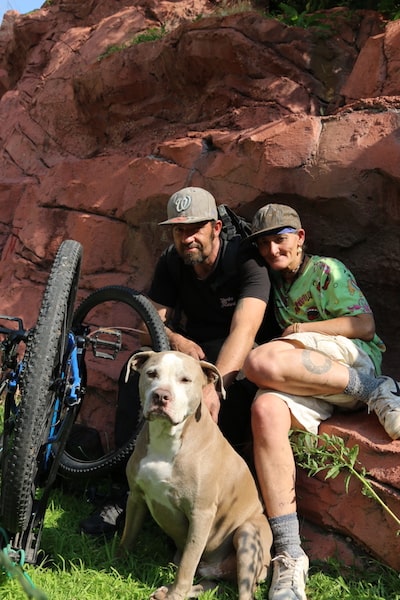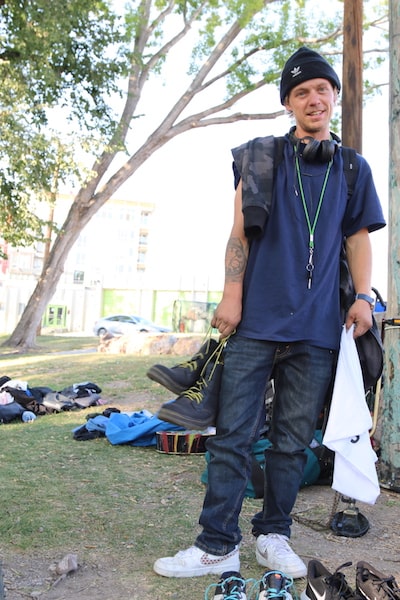
As apartment buildings rise and the shelters fill, the voices of the homeless on homeless policy.
“I’ve given up on the homeless resource center,” said a man who we’ll call John. Now camping around Fairmont Park for the past few months, John added, “They say they want to help, but I showed up two minutes after eight o’clock and they took my room and kept all of my possessions,” he says.
John added that while the new resource centers are very nice, it was unbelievable they wouldn’t return to him most of his clothing, his bicycle, and his toiletries. “I’d rather camp with these guys, who feel like family.”
John epitomizes how most homeless campers feel about the resource centers. Those who choose to live outside rather than in a shelter are afraid of catching diseases in the shelters, and many fear that their belongings will be stolen. I spoke to about six homeless people in two weeks around Sugar House, and while they understand that camping is illegal, they feel like it’s the best way to feel more in control of their lives.
Sam, a twenty-six-year-old man who has been homeless for just a few months, came to Salt Lake City from a Utah County rehab facility. He says, “I came here to be free.” Sam says he has been in therapy nearly his entire life, and was forced Mormon and has felt shame his entire life for not fitting in. “People have always wanted to tell me there is something wrong with me, and I need to be on medication. There is nothing wrong with me.” Sam quit his rehab and now says, “I want to figure out who I am, then one probably one day I’ll probably decide to go back to work. I was a hod tender for six years. Maybe one day I’ll wake up and say, ‘I want to work.’”
But for now, he wants to be free of people trying to figure out what’s wrong with him. Sam said his dad was out just last night looking for him, worried. But he says he is managing to get by because the people he has met in Fairmont Park look out for each other. The cops come every couple of days to clear out the park, and the homeless population has adapted by not using tarps or tents.
Sam and others say they live on food stamps and find metal to recycle and search the dumpster for things they can sell to buy drugs.
Meanwhile, just across the street, the brick and blue-glass luxurious SugarMont apartments are nearly completed. The Dixon building, which is also a high-end luxury apartment building, is now for rent, and the area is filling up with new residents.
For the past six years in September, Utah Stories has examined the homeless situation by speaking to homeless residents as well as people who work directly with the homeless. This year it seems like residents, workers, and the homeless themselves, feel like the situation is mired in a bureaucracy. We will be offering more parts to this story online.
“We Have Lost Out City”
“We have lost [our city]! Said Salt Lake City Business leader and former mayoral candidate, David Ibarra, in a recent interview with Utah Stories. He added, “At night time, it is the saddest thing to hear people screaming out of their minds, yelling profanity, whining, moaning, tents everywhere.” He later added, “And it’s not too late for this Mayor, and it’s not too late for this City Council. We can solve this, they have to look for the solutions and the people that can. And there are plenty of people who can.”
Salt Lake City Mayor, Erin Mendenhall, inherited a big problem: Salt Lake City’s residential population has risen by 13,300 residents. Rental and housing costs have increased by nearly 30% in the past year alone, and the city’s homeless population is growing despite the recent investment in three new resource centers, costing taxpayers more than one hundred million dollars.
Pioneer Park isn’t full of homeless people as it once was, but the population of those who have no shelter has increased. The city and the new “Homeless Tzar”, Wayne Niederhauser, are taking measures. The main issue now: The former Road Home costs around $3.5 million per year to operate, while the three new resource centers combined cost $15 million per year to operate, according to the Salt Lake Tribune.
Earlier this year, the city celebrated the opening of The Magnolia, an apartment building that will provide 65 permanent supportive housing apartments for chronically homeless people, as part of the Housing First Initiative. The cost was $17 million. That’s $261,540 per unit. This amount will result in a decrease in the overall costs of caring for these people in resource centers, jails, emergency rooms, and rehab facilities over the long term, but is this really the best we can do?
Imagine you’ve been homeless and you’re considering getting a job and cleaning up, but you have a buddy who just received housing at Magnolia. Would it be better to go out and get the job, or remain homeless a little longer and get the free housing that Housing First offers? It’s a difficult question to ask, but it’s worth asking: Are we incentivizing chronic homelessness by offering them free housing?
On the bright side, Salt Lake City’s homeless population is still nowhere close to the levels of Los Angeles at 66,000, Seattle at 11,600, or San Francisco at over 17,000. But the severity of the issues surrounding the homeless population range from discarded needles, to fecal matter and garbage accumulation on public property, and unsightly tent cities taking shape all over the city, and it’s taking a toll on residents. Those who are witnessing the short-term solutions, including the city’s “abatement programs”, which are measures to eliminate tent and tarp encampments, appear to be very costly short-term solutions.
The Salt Lake City Police Department’s initiatives to remove homeless encampments have now occurred in nearly every part of the city including Pioneer Park, 900 South and State (across from Sears), North Temple, around the former Gateway Motel, and recently the Rio Grande area where the former homeless shelter is now an empty lot for sale.
Spreading out the homeless and dispersing them has been Utah’s solution. Unlike larger metropolitan areas, Salt Lake City is not allowing encampments to remain long-term. Homeless advocates say these constant abatements are inhumane, while others say it’s inhumane to allow people to publicly camp in squalor.
David Ibarra says there are solutions that could be implemented, but he believes the administration is simply choosing to maintain the same failed policies that don’t work in other large metropolitan areas. Ibarra points to the ever-increasing administration costs and says the police department is very top-heavy. He believes a greater allocation for long-term solutions is necessary, including a well-thought-out program to work with the chronic homeless population by treating their mental illnesses and addictions.
At least 80% of the chronic homeless population has untreated mental illness or addictions. If we treat those issues, we could easily cut the number of homeless residents in half. As Utah Stories found, there is a certain percentage of the homeless population who are choosing to be “homeless by choice”, meaning it’s a lifestyle preference. For these people, Ibarra believes there should be a field-house-style shelter, and public camping should be illegal.

A Viable Answer: Tiny House Villages
“The resource centers are homeless shelters,” Ibarra added. “And they are run by the same people who ran the shelters who said the resource centers should never be built.” Ibarra said there is an excellent solution that The Other Side Academy executive director Joseph Grenny is ready to move forward with, but they are failing to secure a building site due to local stakeholders who don’t understand that this idea is not like “the projects” — it’s a community.
Tiny home communities have successfully been rolled out in Austin, Texas, known as Community First! The community requires all residents to remain sober, and maintain responsibility for maintenance of the facilities and the cleanliness of the grounds. And something new: residents must pay rent. Plenty of jobs programs are offered, making the job requirement part not difficult.
Joseph Grenny began The Other Side Academy to offer convicted felons, who had lost hope of finding gainful employment, a second chance at life by offering both long-term housing and employment. They started a furniture moving company and eventually added thrift stores. The strict agreement has been that residents maintain sobriety.
Neighbors of the Otherside Academy, located at 700 East and 200 South, agree that the Otherside residents have taken ownership over the community and have been excellent neighbors. Still, the tiny home village has not received widespread buy-in from city leaders and plans remain stalled.
“They cannot do it without the Mayor’s approval. We can’t make it happen without her.” Ibarra said they need her to help pass the zoning requirements to make the community possible.”
But objections to putting this community on the west-side (at 1850 West Indiana Ave.) has created opposition.” Ibarra says this shouldn’t be examined as Salt Lake City’s problem but as a regional or state-wide issue. He added, “This issue involves all cities along the Wasatch Front. We need to see everyone take ownership of the problem, and the State Legislature needs to be more involved.”






